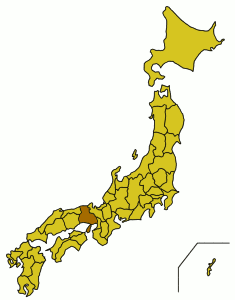Hyogo
Hyōgo Prefecture (兵庫県 Hyōgo-ken) is in the western Kansai region of the main Japanese island Honshu.

Understand
When Japan's prefecture system was inaugurated in the first years of the Meiji era, most of the modern prefectures were made out of one or two of the old Japanese provinces (Hiroshima was once the provinces of Bingo and Aki, Nara was once the province of Yamato). Hyogo, however, inherited three whole provinces and sections of two others. These include:
- Tajima - In the north of Hyogo along the Sea of Japan
- Harima - In the southwest of Hyogo along the Inland Sea, home to Himeji
- Awaji Island - At the entrance of the Inland Sea, culturally linked to Shikoku
- Tamba - Shared with Kyoto Prefecture, in the northweast of Hyogo
- Settsu - Shared with Osaka Prefecture, home to Kobe and the Hanshin area
While these provinces no longer exist in any administrative sense, they came in to Hyogo with distinct regional dialects and identities. This combination has made Hyogo one of the most geographically and culturally diverse prefectures in Japan, and the only one to span the width of the central island of Honshu.
Cities

- 🌍 Kobe - The prefectural capital, a cosmopolitain port city with an international flavor
- 🌍 Aioi
- 🌍 Akashi - Busy seafood market and the world's longest suspension bridge
- 🌍 Ako
- 🌍 Himeji - Home to Japan's most beautiful castle
- 🌍 Kinosaki
- 🌍 Nishinomiya - Home of Koshien Ball Park and The Melancholy of Haruhi Suzumiya
- 🌍 Takarazuka - Famous for its all-female theater productions and Tezuka Osamu Museum
- Takasago
- 🌍 Tatsuno
- Fukusaki
Other destinations
- 🌍 Arima Onsen - Historic hot spring within easy striking distance of Kobe
- 🌍 Awaji Island - Onion farms and large bridges to Shikoku
- 🌍 Shinonsen
Get in
By plane
The prefecture's only significant airport is Kobe Airport (UKB IATA), serving a limited variety of domestic destinations.
Adjacent Osaka Prefecture's two major airports offer many more flights: Kansai International Airport (KIX IATA) is a major international hub, and Osaka Itami (formally Osaka International Airport, ITM IATA) is Kansai's busiest and best served domestic airport. Both have convenient transportation links to Hyogo – Itami is only 40 minutes away from downtown Kobe by bus.
By train
By bus
Get around
See
.jpg)
- Japan's Belly Button Park (日本のへそ公園 Nihon no Heso Kouen). Located in Nishiwaki city, this park marks the geographic center of Japan, which is locally called its belly button. There is a large monument to the belly button, and the park is also home to a children's science museum. If you go in they will eagerly make you watch their planetarium show and then let you use their massive telescope. NOTE that the actual geographic center is not in the park, but down a hill, past the 日本のへそ公園 train station, through a small tunnel and along the Kakogawa river. Don't miss the charming art gallery next to the train station.
- Himeji Castle. One of Japan's best castles, this has recently completed a 5 year renovation.
Do
- Meditation. Antaiji (安泰寺), Kutoyama, Shin-onsen-cho, Mikata-gun. Homepage: antaiji.dogen-zen.de . This is no guest house. Antaiji is a monastery in the Soto Zen school. It was founded in 1923, and made famous as a place for serious meditation and simple living by Sawaki Kodo Roshi and his student, and later abbot, Kosho Uchiyama Roshi. Many foreigners have practiced at Antaiji, and it continues to welcome serious overseas trainees for short and long term stays.
Eat
Drink
Go next
- Kyoto Prefecture borders Hyogo Prefecture to the East. Obviously, the city of Kyoto is a great destination for any tourist in Japan, due to its abundance of historical and cultural sites, such as Kiyomizu Temple and the Imperial Palace. Uji is also worthwhile, with the famous Byodoin Temple, Ujigami Shrine, and Manpukuji Temple. If you are in northern Hyogo, Amanohashidate is a worthwhile destination, with its main attraction being the view, considered to be one of Japan's Top 3 views.
- Tottori Prefecture meets Hyogo on the northwestern border. The city of Tottori is most famous for the Tottori Sand Dunes, the only sand dunes in Japan, as well as the Kannon-in Garden and Kawahara Castle.
- Okayama Prefecture lies to the west of Hyogo. Bizen, located close to Hyogo, is where the famous Bizen swords and Bizen pottery were first made, and there are museums with artifacts and information about making them. The capital, Okayama, features one of Japan's Top 3 gardens, Korakuen Garden, along with Saijo Inari, one of Japan's Top 3 Inari shrines. The city also has a wide variety of museums and Okayama Castle, the famous black castle. The city of Tsuyama features Shurakuen Garden, the historic Joto Street, and Kakuzan Park, which contains the ruins of Tsuyama Castle and is a great place for cherry blossom viewing. Kurashiki is well known for its charming Bikan historic district, a well preserved and quite large area filled with historic buildings, shops, and museums.
- Osaka Prefecture is located to the southeast. The modern city of Osaka features a wide variety of shopping areas, such as Namba and Umeda. This city also features a variety of museums and cultural sites, such as the Kaiyukan, an excellent aquarium, and the famous Osaka Castle. For historic sites, Sumiyoshi Shrine is a great destination, along with Shitennoji Temple. In the city of Sakai lies the Nintoku Tomb, the largest burial mound in Japan. In Suita City one can visit Expo Memorial Park, which is where the 1970 World Expo was held. The famous Tower of the Sun can be seen here.